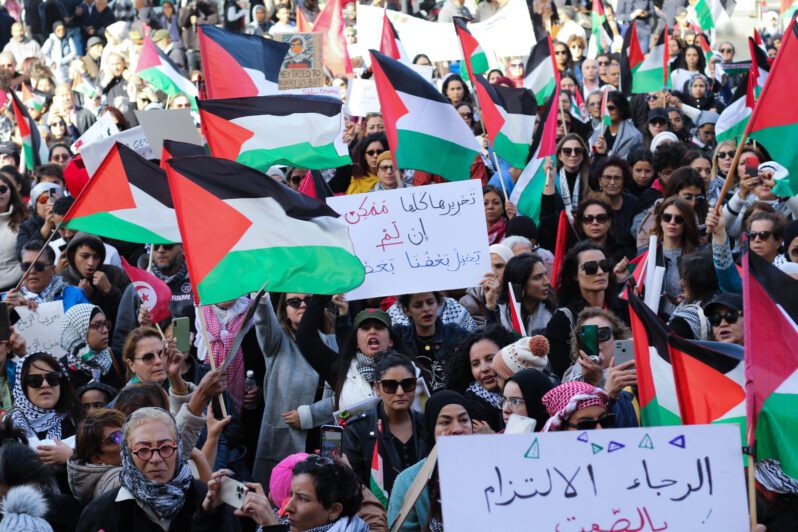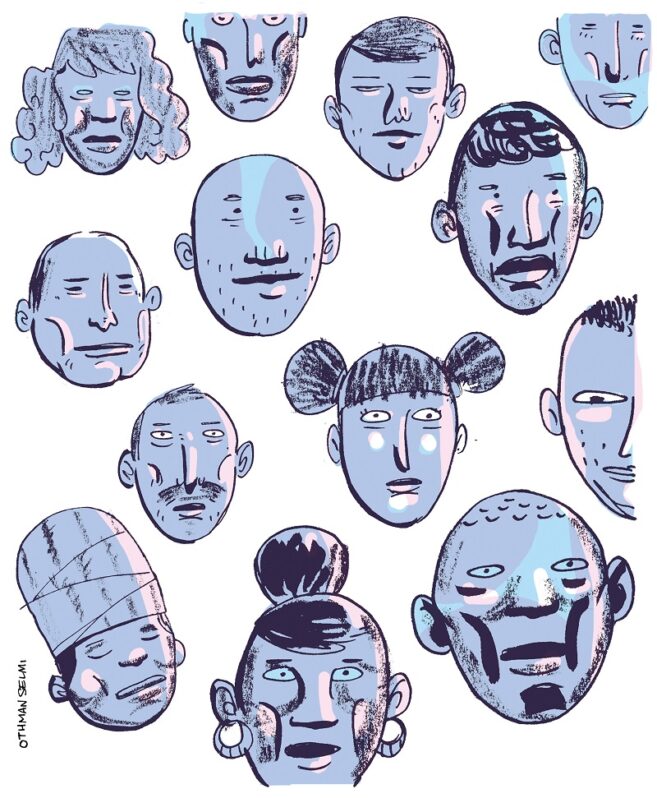Implementing Social Solidarity Economy in Tunisia is Difficult

The approval of Tunisia’s new social solidarity economy (SSE) law on 17 June 2020 was the culmination of a long process that began back in 2011. At that time, revising the development paradigm became a top priority because of its socioeconomic repercussions, which had led to the revolution that the country witnessed in January of that year. Although developing an integrated vision for a bill to regulate this sector took five years and negotiations and amendments between the government and the Tunisian General Labour Union (UGTT) took another four, the more difficult process will be practically implementing the SSE philosophy and overcoming the repercussions of the previous development policies and the situation of the organizations that constitute the bulk of the SSE fabric, as well as ensuring financial independence, which is key to the project’s success.
Born in a Difficult Era
Over the past decade, dozens of studies and even government statistics have revealed that the development paradigm adopted by the various governments since the 1970s has left developmental gulfs between the country’s various regions, violating citizens’ right to socioeconomic equality and to access the various public and private utilities and services. By the beginning of 2020, these policies had sprouted approximately 624,000 unemployed young men and women, including 173,000 university graduates.[1]
Facing the impasse caused by the economic choices that the state had made for decades, the post-2011 governments merely rushed toward borrowing to relieve the social strain and the waves of labor and employment-related protests that swept the country and encompassed most of its sectors. It was a final choice that sealed a vicious cycle of debt, which in turn reflected on the various economic indices. These indices have rapidly deteriorated, particularly during the last five years, as the loans were not spent on development or on creating wealth or jobs.[2] Amidst this predicament, in 2016 the UGTT proposed an SSE bill as a “third way” to resolve the socioeconomic crisis and an alternative to a distressed public sector and faltering private sector.[3]
After a long negotiation and legislation process, Law no. 30 of 2020 on Social Solidarity Economy was issued,[4] representing the first step in establishing this new-old sector. However, this law was born amidst one of the worst economic crises in Tunisia’s modern history – a crisis that will have repercussions for years to come. Because of the COVID-19 pandemic, which led to total lockdowns in Tunisia and most of its economic partners, the country entered an unprecedented economic recession.
This situation devastated most of the economic indices. Economic growth declined by 21.6% during the first half of 2020 in relation to the same period in 2019.[5] The Central Bank of Tunisia also forecasts that GDP growth up to the end of the current year will sharply decline, registering -6.5%.[6] The country’s exports in July 2020 declined by TND495.7 million in relation to the corresponding figure for 2019.[7] The social repercussions of such a decline is a rise in the unemployment rate[8] from 15.3% before the pandemic to 18% at the end of the first half of this year and a forecasted 21.6% by the end of the year.[9] In other words, the new government will face approximately 274,500 newly unemployed people by the end of 2020. The statistics also indicate that the financial poverty rate will rise from 15.2% to 19.2% during the current year, with 475,000 citizens’ income falling below the poverty line.
Hence, from the very beginning, the SSE sector faces new burdens and a further-deteriorating economic situation. Believers in the sector are therefore hoping that it will create an opening in the country’s critical situation and create alternatives that reduce the regional imbalance and generate jobs during a pandemic that has cast its shadow over the world’s mightiest economies. The first experiment in the 1960s occurred amidst the construction of a nascent state searching for a development paradigm to underpin a national economy capable of achieving economic and political independence at the height of the ideological tug-of-war between the two camps dominating the international arena. The new law, on the other hand, shoulders the task of mending the cumulative effects of approximately five decades of economic policies revolving around market economy and the cumbersome legacy of the cooperative experiment, namely an integrated fabric of SSE-sector organizations and enterprises.
The Burdensome Legacy of the 1960s Experiment: Professional Agricultural Organizations as an Example
Although Tunisia is turning a new page with the SSE sector via a legislative framework that breaks with governmental hegemony over its organizations, this experiment drags behind it a fabric of SSE enterprises and organizations inherited from the 1960s cooperative era, especially in the agricultural sector. The professional agricultural organizations it inherits fall into three categories: the mutual societies for agricultural services, the cooperative units for agricultural production that exploit state agricultural lands, and the agriculture and fishing-sector development groups.
These professional organizations provide significant services to farmers. For example, the mutual societies for agricultural services – the successors of the cooperatives of the 1960s experiment – provide agricultural work supplies to approximately 11% of farmers, in addition to collecting and distributing approximately one third of milk harvested, collecting and storing approximately 45% of harvested grain, distributing approximately 80% of chrome products, and providing coaching and guidance to farmers.[10] However, these organizations suffer from a number of issues that obstruct their development and will impact the new SSE experiment. Membership in the mutual societies barely exceeds 5% of farmers in the country. These institutions also have a limited presence in the interior regions most severely affected by the previous development paradigm.[11] In this regard, 74% of the 316 mutual societies are in coastline governorates and only 9.5% are in the distinctly agricultural north-eastern governorates. The mutual societies also suffer from a lack of diversity in the agricultural sectors that their activity encompasses, with harvesting milk constituting 34% of their list of services. One of the mutual societies’ most significant and difficult problems, however, is their debt. In 2019, their debts totalled more than TND400 million, half of which stemmed from the accumulation of bank interest on loans that these institutions previously received.[12]
The situation of the cooperative units for agricultural production exploiting state agricultural lands is no different. Between 1981 and 2017, their number fell from 224 to 18 and the area of the state lands they exploit declined from 237,000 hectares to 16,000 hectares. A May 2020 study by the Tunisian Union of Agriculture and Fisheries concluded that the most significant challenges facing SSE organizations in Tunisia are the small size of the agricultural properties exploited and their fragmented ownership, with 45% consisting of two or more plots, and the age of the farmers exploiting them, with 43% older than 60. Moreover, 84% of people in SSE agricultural organizations have not completed primary education – an issue that has affected the management of these units. The study also observed little cooperative insurance, which reflects the situation of agricultural insurance as a whole: in 2017, agricultural insurance transactions totaled no more than TND7.3 million, i.e. just 0.36% of the value of all insurance sector transactions that year, namely TND2.088 billion.
In theory, these obstacles posed by the current SSE fabric seem addressable via a comprehensive restructuring that supplies the financing and appropriations needed to settle its financial problems and provide new impetus so that it can fulfil the new role envisaged for this sector. However, this very point constitutes the real problem that could block this ambitious project’s implementation and prevent the “third way” – as this sector is commonly called – from being paved.
The Funding Problem: The Defective Launchpad
The new law for the SSE system sought to enshrine financial independence by creating cooperative banks with a standard internal statute based on the General Organic Law for Cooperation. While this step seems, in theory, like the key for ensuring independent and sustainable financing for the various parties involved in the system, implementing it will take at least five years.[13]
However, the legislators also included another mechanism, stipulating that commercial banking institutions should open preferential lines of financing for SSE enterprises.[14] This option seems difficult to realize given the economic recession and the central bank’s policy for handing the inflation problem by raising the policy interest rate,[15] which automatically decreases the volume of loans and reduces liquidity in the financial market.[16] While this policy has been relatively successful in curbing the wave of inflation, it directly affects investments and economic growth, which are directly linked to the growth of the various other sectors. The SSE sector is not excluded from these repercussions, particularly with the increase of commercial banks’ adverse terms for loans and the difficulty accessing them, especially in the agricultural sector. Banking institutions’ financing of the agricultural sector has not exceeded 3% in 2020,[17] whereas they finance 27% of the industrial sector and 70% of the services sector. Similarly, this year farmers have received just 3.5% of the banks’ professional loans.
The third option, namely SSE support from local [collective] authorities, cannot be counted on at present because of the municipalities’ dire financial situation.[18] In addition to the emergency expenses caused by the pandemic, most municipalities suffer from an escalating financial deficit[19] because of poor tax collection, which does not exceed 11% of the taxes owed in some of them. As for non-fiscal resources, the situation is just as bad because a significant number of municipalities have limited real estate assets. The large development imbalance between regions also impacts the ability of municipalities in poorer and more marginalized areas to support SSE as a driver of development to lift the socioeconomic injustice from these areas. In this regard, 77% of municipalities are in delegations with a local development index of less than 0.5 – a measure that varies widely in accordance with the degree of urbanization.[20] Hence, the most fortunate areas will be the best able to finance new SSE projects, whereas the areas most in need of this system will be unable to allocate the necessary appropriations to fund its entrepreneurs.
The last option is to allocate a percentage of public procurements to SSE enterprises and grant tax and financial privileges based on the enterprise’s classification and the nature of its activity irrespective of its region. However, this option remains contingent on the presence in the center of a political will to advance this experiment and therefore makes the development of this system more dependent on the public authorities’ desire and ability to allocate the necessary appropriations. One way or another, this means a government grip over the financing issue and threatens the main principle of the new law’s philosophy, namely financial independence.
Despite the high hopes that SSE believers and theorists place in its ability to overcome the repercussions of the current development paradigm, the process of implementing this law appears very difficult given its timing and the cumulative effects of successive governments’ economic policies. Hence, the question is, will it be possible to surmount these obstacles and turn this sector from a set of pioneering, geographically isolated experiments into an integrated fabric of economic organizations capable of producing wealth, achieving financial independence, and creating new modes of production and marketing that impose themselves on a public sector that refuses to abandon its centralized political and planning mindset and a private sector that rejects SSE competition and any change to the rules of the game?
This article is an edited translation from Arabic.
[1] National Institute of Statistics, monthly statistics bulletin, December 2019.
[2] Tunisian Ministry of Finance.
[3] UGTT initiative concerning a bill for an organic SSE law, June 2016.
[4] On 17 June 2020, Parliament approved an SSE bill with 131 votes for, one abstention, and no votes against.
[5] National Institute of Statistics, monthly statistics bulletin, July 2020.
[6] Central Bank of Tunisia statement on 29 July 2020.
[7] National Institute of Statistics, monthly statistics bulletin, July 2020.
[8] Ibid.
[9] United Nations Development Programme in Tunisia and the Ministry of Development, Investment, and International Cooperation, “Ta’thirat Ja’ihat COVID-19 ‘ala al-Iqtisad al-Tunisiyy Sanat 2020”.
[10] Mohamed Lotfi Frad, general director of financing, investments, and professional organizations, Ministry of Agriculture.
[11] UGTT, “Min Ajl al-Nuhud bi-l-Iqtisad al-Ijtima’iyy wa-l-Tadamuniyy fi Tunis: Nata’ij wa-Tawsiyat Hamlat al-Munasara”, 2017/2019.
[12] Study issued by the Food and Agriculture Organization and the European Bank for Reconstruction and Development.
[13] Interview with Lotfi Ben Aissa, The Legal Agenda – Tunisia, is. 19.
[14] Article 15 of Law no. 30 of 2020 on Social Solidarity Economy, dated 30 June 2020.
[15] The policy interest rate (taux d’intérêt directeur) is the rate that the central bank pays on commercial banks’ deposits, whether the investment is overnight or for a month or more. This rate is an indicator of the interest rates of the commercial banks, which should be no less than the central bank’s rate. The central bank can also control the supply of money in circulation by adjusting this rate up or down in the medium term. Raising the interest curbs borrowing and therefore reduces liquidity in the market, which leads to a reduction in the inflation rate. Put simply, this mechanism involves raising the interest rate that the commercial banks pay to the central bank to obtain liquidity, which is then directed into consumer or investment loans in accordance with interest rates no lower than the central bank’s policy interest rate. The term is used officially by the Central Bank of Tunisia in its statements and media communiques.
[16] Mohammed Samih Beji Okkez, “Masar al-Tarfi’ fi Nisbat al-Fa’ida al-Mudiriyya: al-Tadakhkhum Mutawasil wa-Irtidadat Salbiyya Muntazara”, Nawaat, 13 March 2018.
[17] A study prepared by the Tunisian Union of Agriculture and Fisheries in May 2020.
[18] Mohammed Samih Beji Okkez, “24 Ra’is Baladiyya Yastaqilu: al-Wajh al-Akhar li-Azmat al-Hukm al-Mahalliyy fi Tunis”, The Legal Agenda, 2 November 2019.
[19] Ministry of Local Affairs and the Environment, financial data for municipalities.
[20] Directorate General of Local Authorities,Ministry of Local Affairs, “Taqrir hawla Mashru’ Ta’mim al-Nizam al-Baladiyy”, 25 May 2016.



